-40%
Busch Cup Burr Set No 411 Fraizers 12 Pieces 0.8 - 1.9mm - TFS411
$ 13.75
- Description
- Size Guide
Description
Busch Cup Burr Fig 411 SetHigh quality steel cup burrs by Busch from 0.8mm - 1.9mm (12 burrs).
Comprises of the following internal diameter sizes: 0.80mm, 0.90mm, 1.00mm, 1.10mm, 1.20mm, 1.30mm, 1.40mm, 1.50mm, 1.60mm, 1.70mm, 1.80mm and 1.90mm.
Cup burrs have the cutting edge on the inside of a concave 'cup' shape. They are most often used to round the ends of prongs on settings and the ends of wire.
Don't forget we also sell Burr Life Lubricant (SKU code TG47).
Suitable for quick release handpieces and micromotors. All our Busch pendant motor burrs have a 2.34mm shank to accommodate most handpieces.
Used by jewellers and dentists worldwide.
We are an official UK distributor.
There is no substitute for quality
.
When the brothers Ernst and Otto Busch set up their dental bur factory Busch & Co. in Düsseldorf in 1905, they could hardly have imagined that these words would describe its output just 100 years later!
Their intention was to give a boost to dentistry, a field which was still in its infancy at the time (there were just 500 dentists in the whole of Germany in 1905), by producing better instruments. They and the two following BUSCH generations succeeded admirably in this respect, as the entire history of the company, which moved to Engelskirchen in 1908, is characterized by constant adjustment to the latest developments in science and technology.
https://stores.ebay.co.uk/hswalsh/ - Visit our UK eBay store here.
Cup burrs have the cutting edge on the inside of a concave 'cup' shape. They are most often used to round the ends of prongs on settings and the ends of wire. When the brothers Ernst and Otto Busch set up their dental bur factory Busch & Co. in Düsseldorf in 1905, they could hardly have imagined that these words would describe its output just 100 years later! Their intention was to give a boost to dentistry, a field which was still in its infancy at the time (there were just 500 dentists in the whole of Germany in 1905), by producing better instruments. They and the two following BUSCH generations succeeded admirably in this respect, as the entire history of the company, which moved to Engelskirchen in 1908, is characterized by constant adjustment to the latest developments in science an













